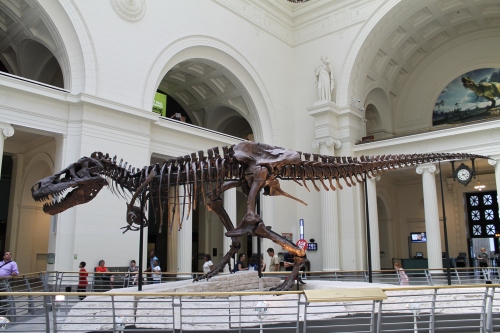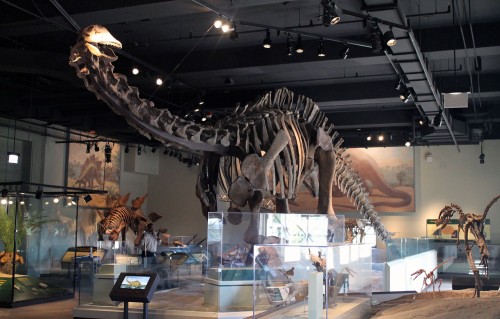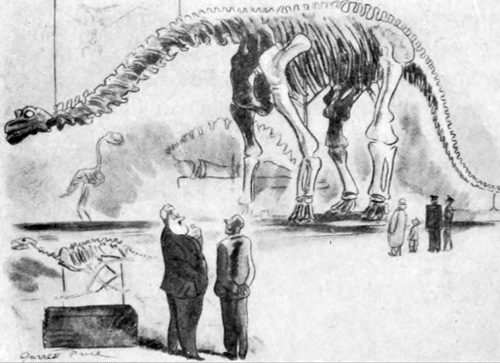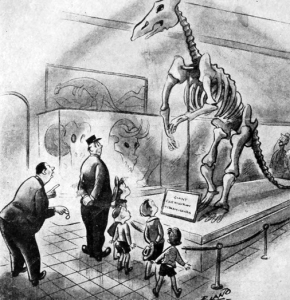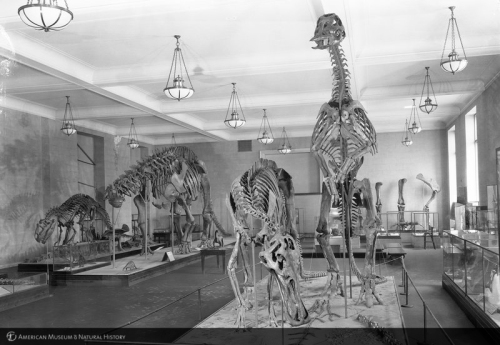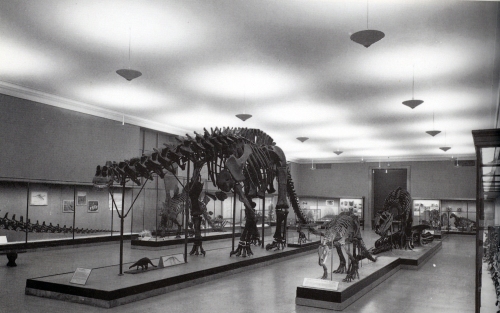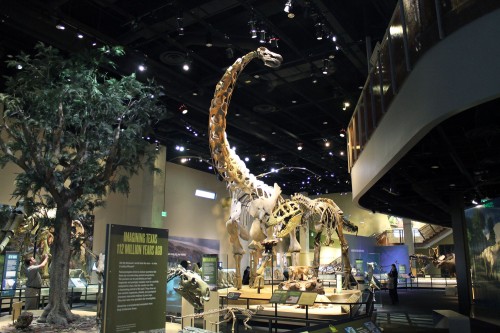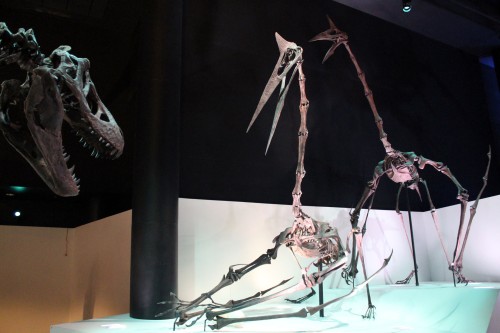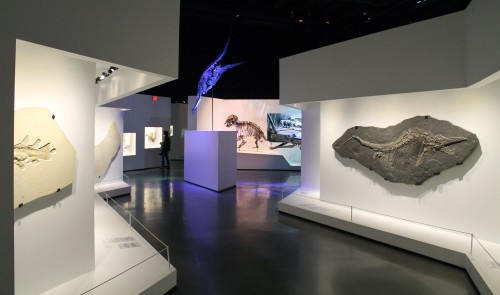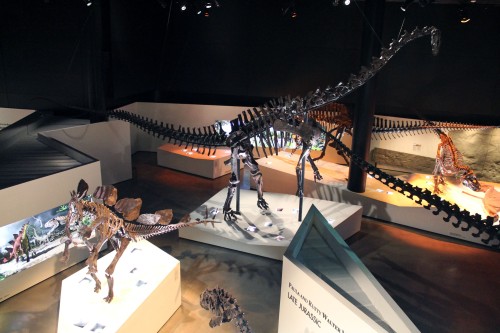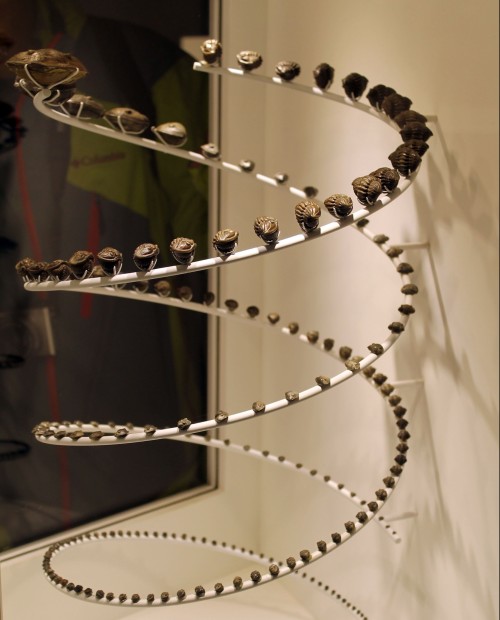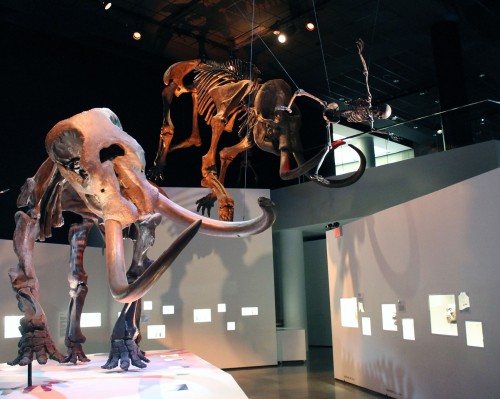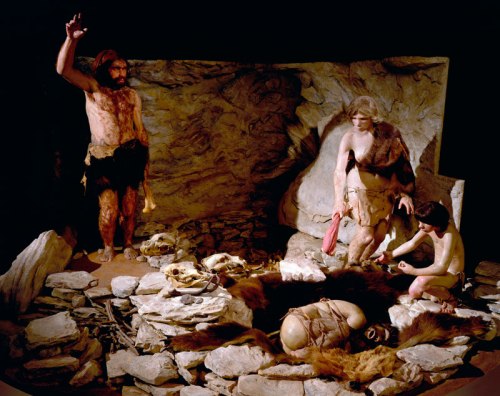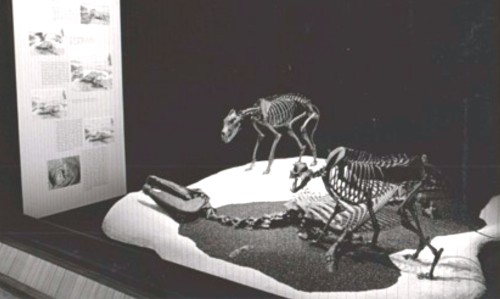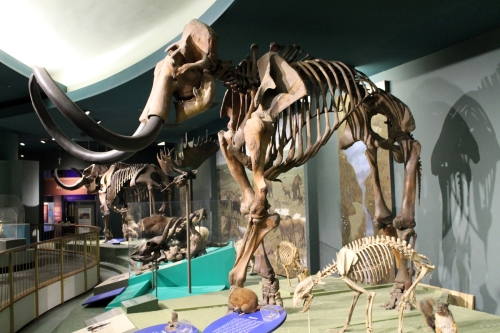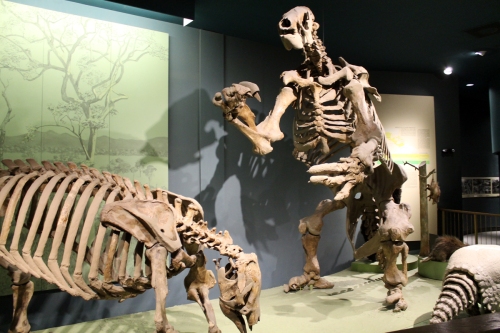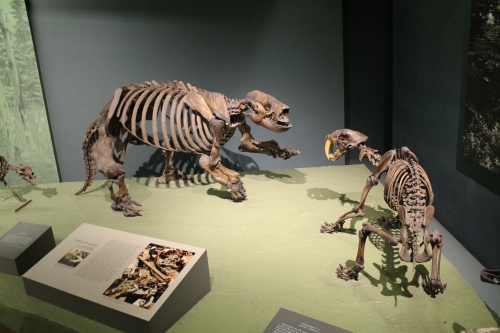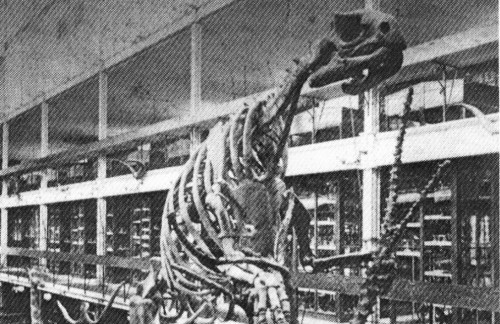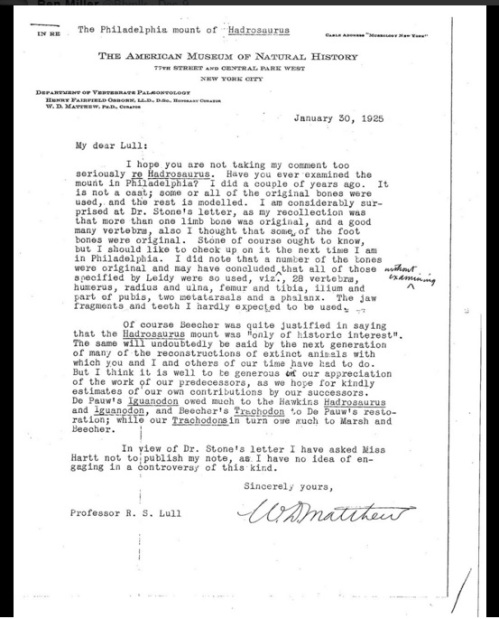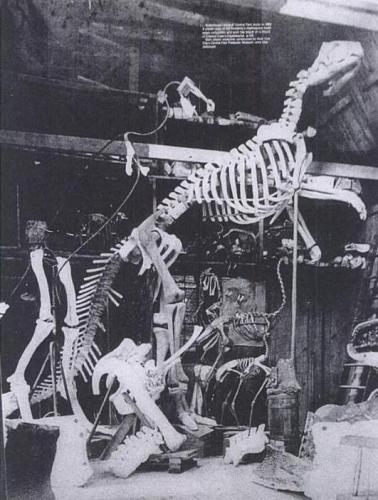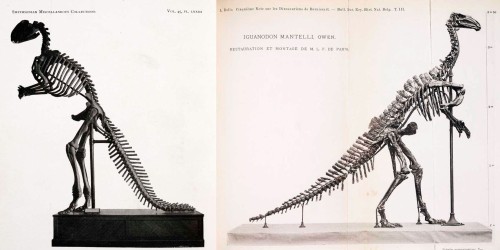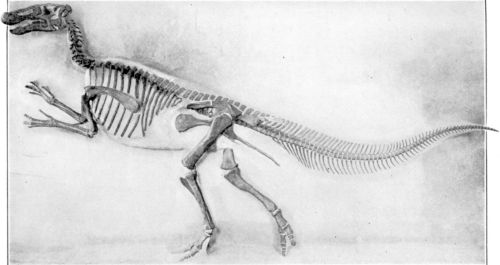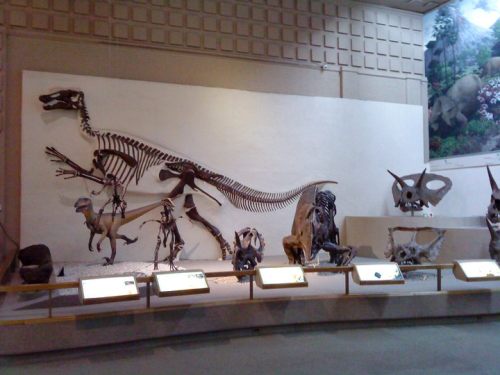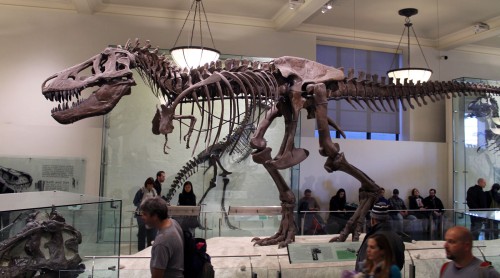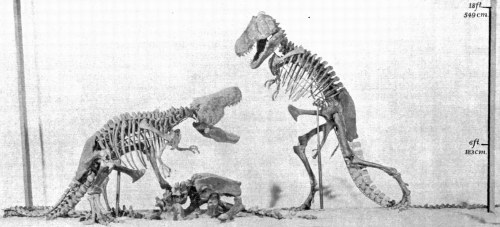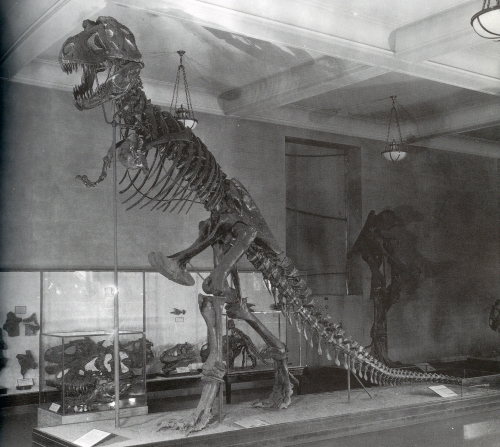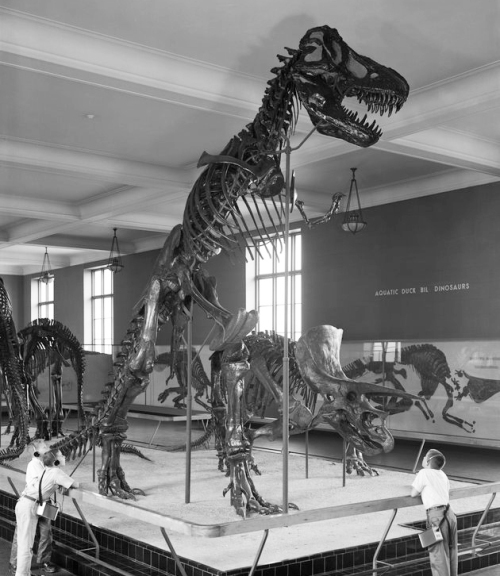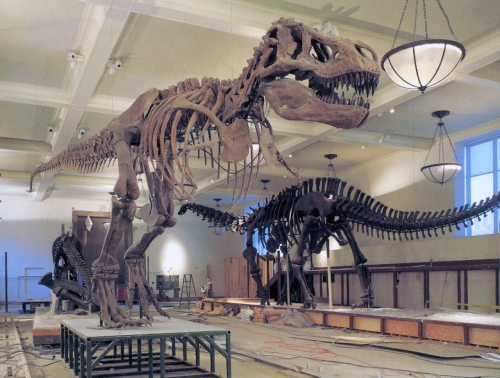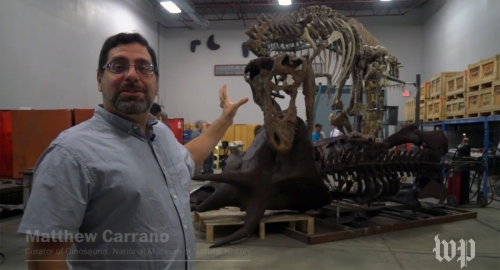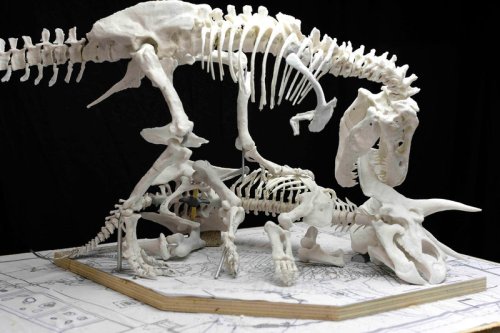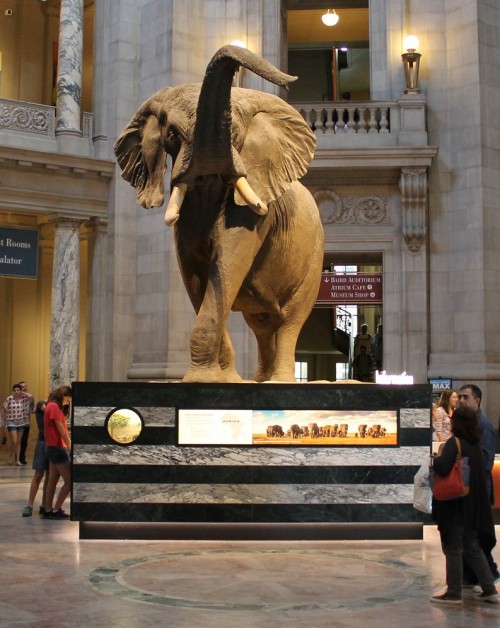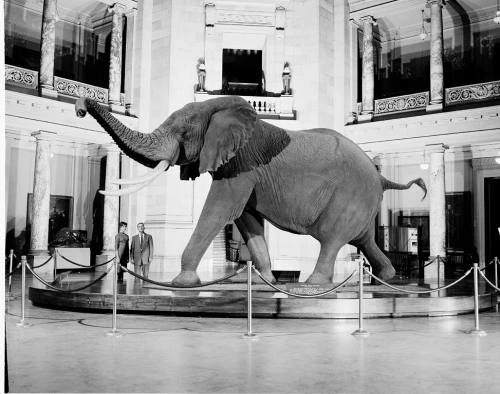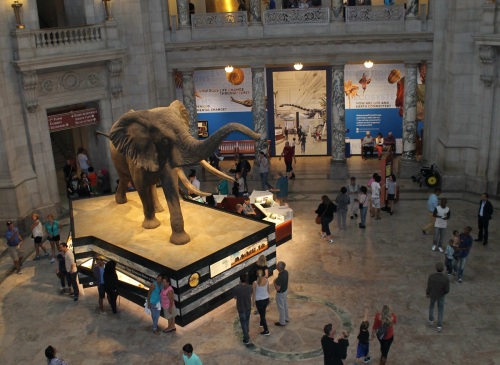Start with History of the Field Museum Fossil Halls – Part 1.
Where we left off, the fossil exhibits in Halls 37 and 38 at the Field Museum of Natural History had gone for decades without more than piecemeal improvements. In the meantime, the field of paleontology – and our understanding of dinosaurs in particular – had progressed by leaps and bounds. What’s more, standards for natural history exhibits had changed. Cases of specimens with esoteric labels written by curators past were no longer enough. Visitors expected exhibits that were relatable and accessible for children as well as interested adults, and multimedia and interactive elements had become standard. This combined with ever-growing public interest in all things prehistoric gave Field Museum staff serious incentive to start with a clean slate.
Phase III: Life Over Time
The end of the old fossil halls came not with a bang but with a whimper. In 1990, specimens started disappearing and areas were roped off without warning. Hundreds of specimens were relocated to Halls 25, 26, and 29 on the other side of the second floor, where they would be part of the exhaustive new exhibit “Life Over Time.” Meanwhile, Halls 37 and 38 became the home of the pacific islands exhibit and Ruatepupuke II, the Maori Meeting House.

Remounted Daspletosaurus in Life Over Time, then labeled Albertosaurus. Photo courtesy of the Field Museum Photo Archives.
As the name suggests, Life Over Time was a chronological journey through the history of life, from its origins around four billion years ago up to the last ice ages. Paleobotanist Peter Crane chaired the Geology Department during the development period, and geologist and children’s education specialist Eric Gyllenhaall oversaw the contractors and in-house staff that created the the exhibit itself. In total, the project took five years and cost $7 million.
Gyllenhaal and the rest of the team conceived of Life Over Time as a directed experience. The space was shaped like a U, with switch-backing corridors flanking a more open dinosaur section in the middle. With the exception of a shortcut between the Carboniferous and the Mesozoic, visitors had no choice but to walk through the exhibit chronologically, viewing the displays in the order the designers mandated. Since visitors tend to be more focused and more likely to read signs early in the exhibit, the designers deliberately used the introductory rooms to cover the most unfamiliar concepts. Displays on the origins of life and the evolution of aerobic respiration made up the “homework” part of the exhibit. After that, visitors were set free in the Mesozoic section, where open sight lines allowed people to choose what they wished to view, and in what order. This served as a reward for putting up with the more challenging material early on. Ultimately, what set Life Over Time apart from its predecessors was the focus on ideas rather than specimens. The fossils were meant to illustrate broader concepts like adaptation, extinction, and biogeography, and were in some ways subordinate to the hands-on activities and multimedia displays.
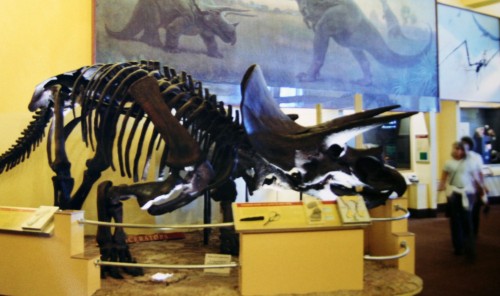
This cast of the AMNH Triceratops was a new addition to Life Over Time. Photo by Gary Todd.
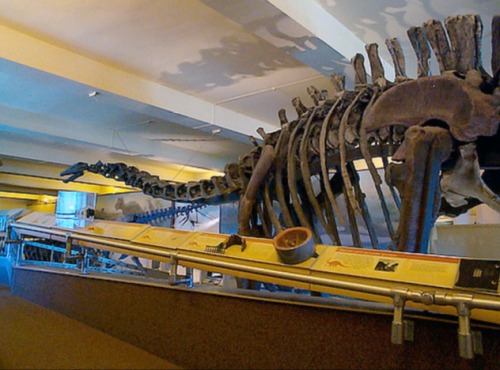
In Life Over Time, visitors circled the dinosaurs on an elevated ramp before visiting them at ground level. Photo by Erik Peterson.
The process of developing Life Over Time was an occasionally tense give-and-take between the research staff (who traditionally had the last word on exhibit content) and the administrators, exhibit specialists, and educators (who had greater influence this time around). Looking back, it would seem that the curators lost more of these fights than they won. Life Over Time ended up with a decidedly kitschy tone, and was full of overtly silly elements. The exhibit entrance featured carnival-style banners advertising “Primordial Ooze” and “Dunkleosteus: Jaws of Death.” Further on, a mannequin dressed as a game show host invited visitors to spin the “Wheel of Adaptation.” There were Dial-A-Dinosaur phones, which visitors could pick up and listen to first-person accounts of life as a dinosaur. An animatronic puppet show explained the switch from aerobic to anaerobic life. Video “weather reports” with CBS anchor Bill Kurtis updated visitors on climate change over time. There was even a ridable trilobite on a spring.
This carnival-like atmosphere is particularly distinctive when compared to the present fossil halls at the American Museum of Natural History, which were developed at the same time. AMNH project director Lowell Dingus rejected contemporary trends in exhibit design, which, in his view, were pitched to “the lowest common denominator of visitor intellect.” Wishing to challenge audiences to think about fossils the way scientists do, Dingus created a phylogeny-based exhibit that emphasized empiricism and rigorous anatomical analysis over idle speculation. While it was certainly not devoid of informative content, Life Over Time was designed for a much younger audience, with particular attention paid to the under-five set. This marked contrast between the New York and Chicago exhibits speaks volumes about the differing influence of the scientific staff at the two museums, as well as the institutions’ overall priorities at the time.
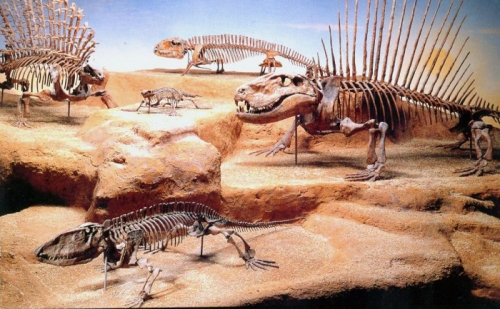
Postcard of the pelycosaur cluster in Life Over Time. These specimens were donated by the University of Chicago in the 1960s.
Happily, the Field Museum didn’t opt to replace its authentic mounted fossil skeletons with the roaring robots that were in vogue at the time. The classic fossil mounts were restored and rebuilt by Prehistoric Animal Structures, Inc., a Canadian company headed by Gilles Danis. A biologist by training and a veteran of the Royal Tyrell Museum, Danis led the process of disassembling, cleaning, and remaking the most significant mounts. The Apatosaurus, Daspletosaurus, and Megathierum were all given more accurate and active poses: the Daspletosaurus now crouched over its Lambeosaurus prey with its tail held aloft, while the giant sloth stretched to its full height against a replica tree. Although it was completely rebuilt, the Apatosaurus retained its dragging tail in the new exhibit – an unusual choice for a 1990s reconstruction.
In addition to the classic mounts, Life Over Time featured a partial Parasaurolophus and a new cast of the AMNH Triceratops. The most substantial addition was a complete Brachiosaurus reconstruction. This 40 foot tall mount combined casts taken from the material Elmer Riggs collected at the turn of the century with sculpted elements prepared by Stephen Godfry. Far too large for the second floor exhibit halls, the Brachiosaurus earned a place of honor in the central Stanley Field Hall. In order to comply with the fire code while allowing visitors to walk under the towering sauropod, the torso was extended by adding two extra dorsal vertebrae (for a total of twelve). In an amusing twist, newer research shows that this vertebrae count – and the mount’s stretch limo proportions – is probably correct.
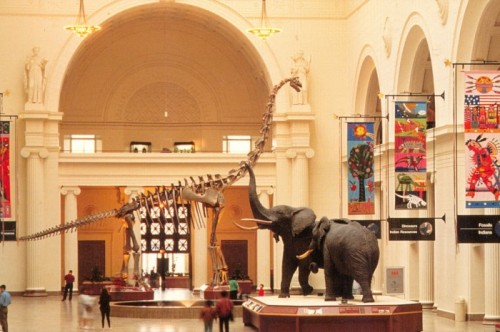
The Brachiosaurus skeleton was tall enough to look over the second floor mezzanine. Source
Life Over Time opened to the public in June 1994 (the Brachiosaurus had been on display for a year prior). Nevertheless, it was the shortest-lived iteration of the Field Museum’s fossil displays, closing down after only ten years. Why didn’t it last? For one thing, the numerous interactive elements suffered more wear and tear than expected, and they broke frequently. Meanwhile, in-house evaluations showed that the exhibit’s intended messages were not coming across to most visitors. For example, Asma recalls a child frantically spinning the Wheel of Adaptation with all his might, completely oblivious to the information the display was meant to convey. Unfortunately, an interactive exhibit is not necessarily an educational one, and it can be very difficult to create a learning experience that accomplishes both goals.
Phase IV: Evolving Planet
There was one more reason the Field Museum needed to revisit its fossil displays: the sudden acquisition of Sue the Tyrannosaurus in 1997. The story of the four-way legal battle that preceded this has been told often (although not always fairly), so suffice it to say that few came out of that fight unscathed. The Field Museum entered the picture when landowner Maurice Williams, to whom the courts had awarded ownership of Sue, announced that the fossils would be placed on the auction block. Paleontologists initially worried that the priceless specimen would disappear into the hands of a wealthy collector, or end up in a crass display at a Las Vegas casino. Those fears were put to rest when the Field Museum won Sue with financial backing from McDonald’s and Disney. Including the auctioneer’s commission, the price was an astounding $8.36 million.
The Field Museum committed to a summer 2000 unveiling of Sue’s mounted skeleton. However, most of the bones was still buried in rock and plaster. The fossils had to be prepared and stabilized before they could be studied, and they had to be studied before they could be mounted. Most of this work was done on-site, in view of the public. The armature itself was created by Phil Fraley Productions, the same exhibit company that rebuilt the AMNH Tyrannosaurus. Field Museum administrators decided that Sue would replace the Brachiosaurus in the Stanley Field Hall, even though the sauropod had only been on display for seven years. According to Exhibit Project Manager Janet Hong, Sue was such a monumental exhibit that it really deserved pride of place. Meanwhile, the Brachiosaurus was relocated to O’Hare International Airport, while a weather-proof duplicate was placed outside the museum.
Sue was revealed to the public on May 17, 2000 with the literal raising of a curtain. A week-long series of celebrations and press junkets introduced Sue to Chicago, and it has been one of the city’s biggest attractions every since. All the publicity paid off, at least in the short term: Field Museum attendance soared that year from 1.6 million to 2.4 million. 16 years later, Sue’s new identity as a Chicago landmark seems to have all but eclipsed the legal dispute that was its original source of fame. Hong likens Sue to Chicago’s David, and even former Field Museum President John McCarter feels that he underestimated what a force Sue would be for the city.
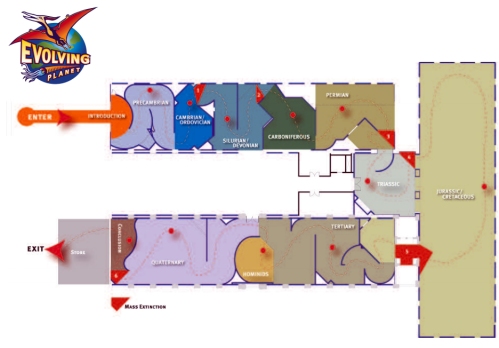
Map of Evolving Planet. Source
The acquisition of Sue created a strong public association between the Field Museum and dinosaur research. This was ironic, because while the museum had hosted a talented array of paleontologists over the years, it had never employed a dinosaur specialist. Even Elmer Riggs, who collected the museum’s iconic sauropods at the turn of the century, was more interested in mammal evolution. In 2001, the Field Museum began a concerted effort to expand its vertebrate paleontology program, and make a name for itself as a hub for dinosaur science. Among the new hires were fossil preparator Akiko Shinya and paleontologist Peter Makovicky, who immediately began organizing expeditions to grow the museum’s collection.
The new emphasis on paleontology research brought greater expectations for the Field Museum’s interpretive efforts, and Life Over Time wasn’t doing the job. The initial plan was to merely refresh the decade-old exhibits, but ambitions grew and the renovation snowballed into something much more substantial. Project Manager Todd Tubutis and Content Specialist Richard Kissel spent five years overseeing the development of Life Over Time’s replacement, eventually titled “Evolving Planet.”

Each section of Evolving Planet is differentiated by its own color palate and ambient audio. In the Permian, olive green walls and signs are accompanied by the sounds of a windswept desert. Photo by the author.
While the new exhibit uses the same space and directed, U-shaped layout as its predecessor, the end result is virtually unrecognizable. The hokey parts of Life Over Time are gone, replaced by all-new signs, labels, and interactives. New specimens include original Parasaurolophus, Rapetosaurus, and Arctodus mounts, plus casts of Stegosaurus and Deinonychus, all prepared by Research Casting International. An entire room is dedicated to fossils from Utah’s Green River Formation, acquired on a recent Field Museum collecting expedition. Phlesh Bubble Studios provided a panoramic CGI reconstruction of the Burgess Shale Fauna, while Karen Carr produced 150 original paintings to supplement the classic Charles Knight murals. These, in turn, were restored by Parma Conservation and are contextualized as the historic masterpieces they are. Nevertheless, Evolving Planet has a few holdovers from Life Over Time. The existing dinosaur mounts were not moved or changed, and major set pieces like the walk-through Carboniferous swamp diorama remain in place.
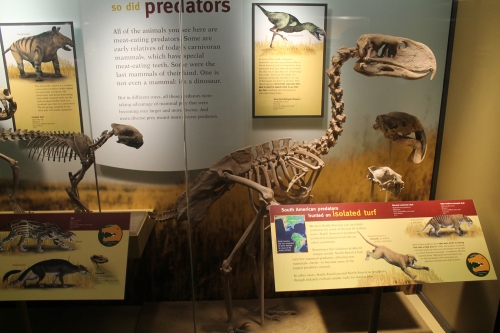
New artwork by Karen Carr fills gaps left by the classic Charles Knight murals. Photo by the author.
The interpretation in Evolving Planet arose from three main objectives. First, the exhibit needed to highlight the Field Museum’s own collections and the work of its in-house research staff. Second, it had to contextualize Sue and the environment they lived in. Finally, it had to effectively explain the process of evolution, and the evidence for it. Life Over Time had faltered here, and with the influence of the anti-science lobby increasing, it was crucial to get it right. Tubutis and Kissel accomplished this in part by facilitating closer collaboration between the exhibit designers and research staff. Evolving Planet weaves the evidence for evolution into all aspects of the displays. The first thing visitors see is the thesis of the exhibit – “everything that has ever lived is connected through and is the result of evolution” – printed on an otherwise blank wall. Moving forward, visitors learn how evolution via natural selection works, and how we know. Along the way, common misconceptions, such as the idea that lineages improve over time, or that evolution is “just a theory”, are proactively addressed and corrected.
The visual design of Evolving Planet deserves particular mention. The new exhibit subtly but effectively uses repeating iconography to guide visitors through the story being told. Every geological period is associated with a specific color scheme and soundscape, making visitors’ progression from one stage to another obvious and distinct. “Timeline Moments” at the beginning of each section update visitors on their progress, and ensure that they expect to see something new and different up ahead. Special symbols remind visitors of recurring themes, such as mass extinctions (or even the repeated evolution of saber-teeth). Lastly, variations in font and text size are cleverly employed to call attention to key words and phrases.

A new pose and context for Megatherium, along with historic Riggs mounts and Knight artwork. Photo by the author.
Evolving Planet opened on March 10, 2006. A decade later, this award-winning exhibition remains a favorite with scientists and educators alike. As Cleveland Museum of Natural History Educator Ashley Hall explains:
Evolving Planet is my all-time favorite museum exhibit. It is not only rich with some of the world’s best known fossil specimens, but provides label copy for visitors of all learning levels. You can visit multiple times and still learn something new. Museums provide visitors with unique settings for learning, and it is a museum’s job not to short-change, dumb down, or simplify information. Evolving Planet hits the nail on the head.
From its clear-as-day thesis to its poignant finish (a counter showing the number of species going extinct daily), Evolving Planet is ambitious but uncommonly relatable. It places familiar dinosaurs and mammoths in a broader evolutionary context, introducing visitors to the true breadth of deep time. And yet, the exhibit is also remarkable for its restraint. It doesn’t overwhelm casual visitors with specimens and facts, but instead sticks to a handful of broadly-applicable themes.
The Field Museum’s paleontology program spent its early years playing catch-up to peer institutions. While other American natural history museums were conducting yearly fossil-collecting expeditions and building collections of one-of-a-kind specimens, the Field Museum’s founding paleontologists struggled for basic resources and recognition within their institution. Today, the department’s public showroom is what Kissell describes as “one of, if not the, most comprehensive explanations of the history of life on Earth in any museum.” It would seem that the Field Museum has found its voice in the pantheon of great natural history museums.
Many thanks to Ashley Hall, Olivier Rieppel, Bill Simpson, and Devin Myers for sharing their time, expertise, and experiences when I was writing this post. Any factual errors are, of course, my own.
References
Asma, S.T. 2001. Stuffed Animals and Pickled Heads: The Culture and Evolution of Natural History Museums. New York, NY: Oxford University Press.
Dingus, L. 1996. Next of Kin: Great Fossils at the American Museum of Natural History. New York, NY: Rizzoli International Publications, Inc.
Fiffer, S. 2000. Tyrannosaurus Sue: The Extraordinary Saga of the Largest, Most Fought Over T. rex ever Found. New York, NY: W.H. Freeman and Company.
Glut, D.F. 2001. Remembering the Field Museum’s Hall 38. Jurassic Classics: A Collection of Saurian Essays and Mesozoic Musings. Jefferson, NC: McFarland.
Lee, B.M. 2005. The Business of Dinosaurs: The Chicago Field Museum’s Nonprofit Enterprise. Unpublished thesis, George Washington University.
Lelièvre, M A. 2006. Evolving Planet: Constructing the Culture of Science at Chicago’s Field Museum. Anthropologica 48: 2: 293-296.
Milner, R. 2012. Charles R. Knight: The Artist Who Saw Through Time. New York, NY: Abrams.
Tubitis, T.J. 2005. Revitalizing Life Over Time: A New Look for a Very Old Topic. In the Field 76: 2: 18.

